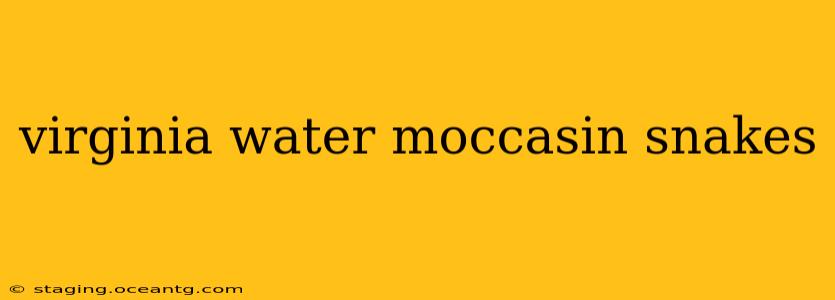Virginia is home to a variety of fascinating wildlife, but among the most feared are its venomous snakes, particularly the water moccasin, also known as the cottonmouth. Understanding these creatures is crucial for safety and appreciating their role in the ecosystem. This comprehensive guide delves into the characteristics, habitat, behavior, and potential dangers of Virginia water moccasins.
What is a Water Moccasin (Cottonmouth)?
The water moccasin ( Agkistrodon piscivorus ) is a venomous pit viper found in various southeastern US states, including Virginia. Often confused with other non-venomous snakes, the cottonmouth possesses several key identifying features. Its most distinctive characteristic is its broad, dark-colored head, noticeably wider than its neck. Adults typically have a dark, olive-brown or black body, often with darker crossbands. Young water moccasins, however, exhibit a striking pattern of dark bands on a lighter background. They are stout-bodied snakes that average 2-4 feet in length, though some can grow larger. The name "cottonmouth" derives from the white interior of their mouths, which they display as a threat display—a defensive posture that involves opening their mouths wide, revealing the white lining.
Where are Water Moccasins Found in Virginia?
In Virginia, water moccasins inhabit primarily the southeastern portion of the state, particularly along rivers, swamps, marshes, lakes, and other slow-moving waterways. They prefer environments with abundant vegetation, providing cover and hunting grounds. They are adept swimmers and are often found basking on logs or rocks near the water's edge. Their range is more limited in Virginia compared to other southern states, concentrating in areas with suitable wetland habitats.
Are Water Moccasins Aggressive?
While water moccasins are venomous and capable of inflicting a painful bite, they are generally not inherently aggressive. They are more likely to strike if they feel threatened or cornered. Most bites occur when humans inadvertently approach or handle them. Therefore, the best way to avoid a bite is to give them a wide berth and never attempt to handle or provoke them. Their defensive posture, the gaping mouth revealing the white inside, is often a warning sign to keep your distance.
What to Do if You See a Water Moccasin?
The safest course of action when encountering a water moccasin is to slowly and calmly back away. Avoid sudden movements or attempts to kill or capture the snake. Give the snake ample space, and it will likely move away on its own. If you're hiking in areas known for water moccasin habitation, wearing appropriate footwear and using a walking stick can help deter accidental encounters.
How Dangerous is a Water Moccasin Bite?
A water moccasin bite is dangerous and requires immediate medical attention. Their venom is hemotoxic, meaning it affects blood cells and tissues, causing pain, swelling, bruising, and potentially tissue damage. Seek immediate medical assistance at a hospital capable of providing antivenom. While fatalities are rare with proper medical treatment, it's crucial to seek help promptly to minimize the risk of severe complications.
How Can I Protect Myself from Water Moccasin Bites?
Preventing encounters is the best way to avoid water moccasin bites. When recreating in areas known for these snakes, take these precautions:
- Wear protective footwear: Closed-toe shoes or boots will help protect your feet from bites.
- Stay on marked trails: Sticking to marked trails reduces the chance of encountering snakes.
- Avoid reaching into crevices or under rocks: Snakes often seek shelter in these areas.
- Be cautious near water: Water moccasins are commonly found near water sources.
- Use a walking stick: This can help you detect snakes hidden in tall grass or vegetation.
What are the Differences Between a Water Moccasin and a Non-Venomous Water Snake?
Many people mistake non-venomous water snakes for water moccasins. Key differences include the broader head of the cottonmouth (noticeably wider than its neck), the distinctive pattern (young cottonmouths have bands, adults have darker, less defined markings), and the aforementioned threat display of opening its mouth to show the white lining. If unsure, it's best to err on the side of caution and maintain a safe distance. There are numerous online resources with images to help you differentiate between the two.
What is the role of Water Moccasins in the Ecosystem?
Water moccasins play an important role in the ecosystem, primarily as predators, controlling populations of fish, frogs, and other small animals. Their presence indicates a healthy wetland environment. Although their venomous nature may evoke fear, they are an integral part of the natural balance.
By understanding the characteristics, behavior, and habitat of Virginia water moccasins, we can appreciate these fascinating creatures while taking the necessary precautions to ensure our safety. Remember, responsible coexistence is key to sharing our natural spaces with wildlife.
